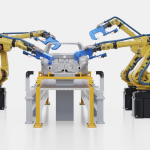U.S. manufacturing activity rose to 49% in June, driven by stronger production and inventory restocking, according to the Institute for Supply Management. But with new orders still falling and sentiment deteriorating, the sector remains in contraction.
Production Lifts, But Demand Signals Stay Flat
U.S. manufacturers saw a modest improvement in June, with the Institute for Supply Management’s Purchasing Managers’ Index rising to 49%, up 0.5 points from May. While still in contraction territory, the uptick was driven by a rebound in production, up 4.9 points to 50.3%, and a 2.5-point increase in inventories to 49.2%, as firms pulled forward imports ahead of expected tariff reinstatements.
The production recovery follows four straight months of decline and came amid better throughput at ports, even as supplier deliveries slowed. The gains, however, were largely tactical. Demand-related components, including new orders, export orders, and backlogs, continued to fall, while pricing pressures persisted.
“The biggest issue on our panelists’ minds continues to be the effect of tariffs on their supply chain and their cost structure,” said Susan Spence, chair of ISM’s Manufacturing Business Survey Committee in an official statement.
Negative Sentiment Deepens as Employment Slips
Sentiment remained sharply negative. For every positive comment ISM received in June, 11 were negative, worse than the one-to-five ratio recorded in May. Employment contracted for the fifth straight month, as manufacturers held off on new hiring amid ongoing cost and trade uncertainty.
Spence pointed to “tariff and whiplash uncertainty” as a recurring concern, with companies uncertain about how long the current policy pause will last. The Biden administration has yet to confirm whether the suspended Trump-era country-specific tariffs will resume in full this month.
S&P Global offered a more optimistic reading, with its U.S. manufacturing PMI rising to 52.9%, the highest since May 2022. That index cited output gains and improved demand, but it also flagged ongoing inflation and pricing pass-throughs as risks. “The big question,” said S&P Global’s Chris Williamson, “is whether this merely results in a short-term change in the price level rather than a more worrying return of stubborn inflation.”
Beware False Signals in Pre-Tariff Activity
The modest gains in output and inventory may offer little more than a temporary cushion. Pulled-forward orders and short-term logistics moves can mask deeper stagnation in demand and confidence. Without resolution on trade policy and cost structures, manufacturers face limited room to plan beyond the quarter, making it difficult to distinguish between resilience and reaction.





